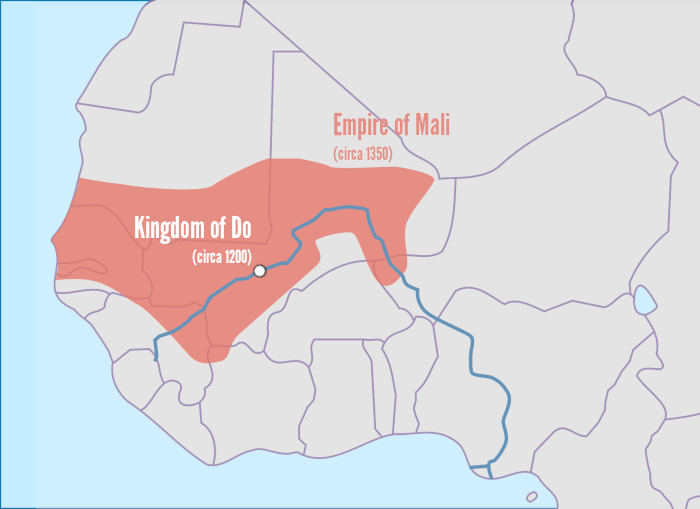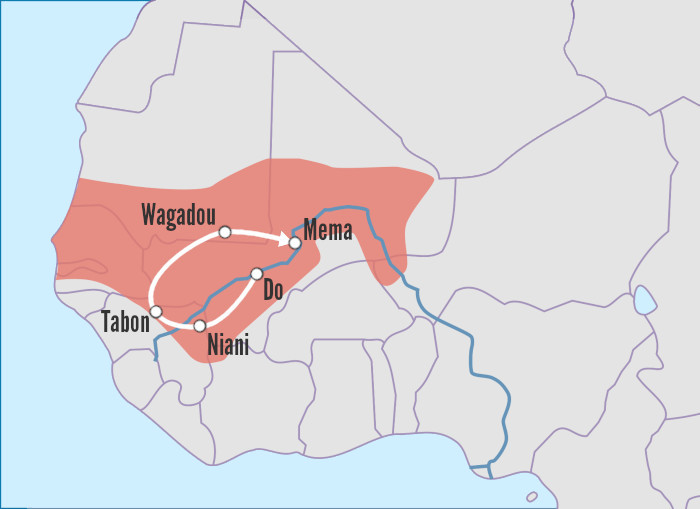Sundiata (circa 1217-1255), the founder of the Mali Empire, is famed in song and story in part because of his eponymous griot-song The Epic of Sundiata. And it’s deservedly famous – it’s a great story! But the coolest character in the epic isn’t Sundiata. It’s his mom, Sogolon Kondé. She’s a sorcerer with a buffalo ghost, a loving mother, and a fascinating figure in one of the great works of traditional African literature. In short: she’s fabulous inspiration for an NPC!
First, a few quick details about the epic. There are many versions, presumably composed at different times – though the events the epic recounts occurred in the 1200s. Some details in the epic are confirmed by outside sources from within a hundred years. Others are unconfirmed. It’s also a great work of literature and a device griots (West African bards) use to reinforce cultural beliefs and norms. You can’t treat the text uncritically as a historical source – but you shouldn’t treat any historical document uncritically, so what else is new? This post is really just skimming the surface of one detail of this delightfully multilayered work.
I’m running a Kickstarter campaign right now for an early-access zine edition of Ballad Hunters, my RPG about magical folk ballads in 1813 England and Scotland. You should check it out!
This post is brought to you by beloved Patreon backer Colin Wixted. Thanks for helping keep the lights on! If you want to help keep this blog going alongside Colin, head over to the Patreon page – and thank you!

We begin our story in the small kingdom of Do, in what is today central Mali. A new king asceded to the throne but deprived his sister of her part of their inheritance. The sister, Sogolon Kondé, was a frightfully ugly woman by the standards of her people. She had a misshapen face, a squat body, muscular arms, and a great hump on her back. So distinctive was her hunchback that her name has become a byword for the condition. But she was also a sorcerer! And with her power, she took her revenge on her brother by attacking his kingdom.
She sent out from her body a part of her soul. Not the part that is immortal and goes to Heaven or Hell, but the part that can turn into a ghost after you die and sometimes needs to be appeased. Many Muslims wouldn’t recognize this belief as being in keeping with the religion. But in West Africa, pre-Islamic beliefs can often mix freely with Muslim ones.
Sogolon sent her soul out to the countryside in the form of a magic buffalo. Every day, the Buffalo of Do killed someone. The king grew wroth. He promised the finest rewards for anyone who could kill the buffalo, but no one could. In this form, Sogolon killed 107 hunters and wounded 77 more before she sated her thirst for revenge. It’s not clear how much control Sogolon really had over her buffalo form. The way the story is told, it’s entirely possible the buffalo-projection was unconscious on her part.
Then Sogolon had to find a way out of Do. She sent her soul to the riverside in the form of a starving old woman. She begged the passers-by for food, but no one would stop. Finally two hunters from far away, pursuing the buffalo and the promised reward, paused to give her some dried meat. These young men were worthy. She told them she was the buffalo in disguise, gave them a magic distaff and egg, and told them how they could use these tools to kill the buffalo. In return, they had to promise to help her. As part of their reward, the king would offer them the hand of any woman in Do. They had to choose Sogolon, whom they’d recognize by her hump.
Everything went according to plan. The two young hunters left Do with the ugliest woman in the kingdom, and the court had a big laugh at their expense.

The two hunters took Sogolon away from Do. But she was too spiritually powerful for them to wed. Only a king could marry someone that powerful, and not just any king. In an attempt to curry favor, the hunters took Sogolon to Niani, in what is today eastern Guinea, where ruled a king named Naré Maghan. Unknown to the hunters, Naré had received a prophecy that he would father a son who would be the last of the great conquerers of the world. He would know the child’s mother because she would be frightfully ugly and hunchbacked. Sogolon was almost too spiritually powerful for Naré to marry, but fate could not be denied. Sogolon soon brought forth a son: Sundiata, the future conquerer of the world!
Sogolon’s life at court was often unpleasant. King Naré Maghan was very fond of her and doted on her and their child. But his other wives weren’t happy to cede primacy to this hideous hunchback. One in particular, Sassouma Bérété, was terrified that her son – the king’s firstborn – would fail to become king because the younger Sundiata would usurp him. So Queen Sassouma worked to discredit Sogolon. She had plenty of ammunition. Sundiata, the future conquerer, was deformed. He had an enormous head, bulging eyes, and couldn’t walk. He didn’t play with the other children, but just crawled around looking for food to steal. Queen Sassouma even hired three witches to kill Sogolon. But they weren’t able to. Three owls – symbols of death – came to perch on Sogolon’s roof and protected her from malign influence.
When King Naré died, the court set prophecy aside and made Queen Sassouma’s son the new king. She would act as his regent until he came of age. The new Queen Mother was all-powerful. She moved Sogolon and her child to a hut in the back yard of the palace where the queen could encourage gawkers to go laugh at the hunchback and her broken child. Sogolon turned all her sorcery to curing Sundiata, to no avail. It was foolish for people to mock Sogolon: she had (perhaps unconsciously) ravaged the land of Do, she was immune to sorcery and protected by owls, and her child was destined to conquer the world. But people are quick to forget, and maybe Sogolon had learned to endure outrages since leaving Do. Still, this was her lowest point.

One day, Sogolon went into the palace to ask Queen Sassouma if she could borrow some baobab leaves to use in cooking. Sassouma mocked her. “Take as many as you like, you poor woman. My son is almost grown and he’s been gathering baobab leaves for me his whole life. Your son is eight and cannot gather a single leaf for you.” The Queen Mother laughed and laughed in that vicious way that cuts to the bone. Sogolon went home and cried. She told all to her son, who suddenly stood up, walked to a baobab tree – one of the great African giants – uprooted the whole thing, and laid it at his mother’s door. “Now when anyone in Niani needs baobab leaves, they will come to you, mother.”
When Sundiata walked, Sogolon’s world changed. Her skills in sorcery were once more respected. She taught the noble children of Niani about all the beasts of the bush. Those who were worthy, she inducted into certain mysteries, including those of the healing herbs that great hunters should know. She looked after some of the late king’s other children. But Sogolon knew she was vulnerable. Now that Sundiata could walk, he was a threat to Queen Mother Sassouma’s power. What if Sassouma had some of the other children killed to spite him?
So Sogolon left Niani. She took Sundiata, his siblings, and some of his half-siblings, and went into exile. She took them to Tabon, then Wagadou, then Mema. She didn’t go back to Do, her homeland, even though a different brother of hers had ascended the throne. There might have still been bad blood there. Through these travels, Sundiata grew into a great man, a warrior who excelled in every moral category save his gluttony. And Sogolon aged. The day when Sundiata left Mema to recover his homeland and found the Mali Empire, Sogolon passed away.

What I love most about Sogolon as NPC inspiration is that she can serve so many different functions, depending on what stage of her life you draw from. An NPC based on a young Sogolon can be the hidden fulcrum of an adventure about a mysterious buffalo that’s terrorizing the countryside. A Sogolon newly arrived at court is a naïve but powerful (whether magically, religiously, or culturally) mover and shaker whose sudden insertion into court drama complicates the PCs’ schemes. A despised and mocked Sogolon living behind the palace is an adventure hook for a party that likes helping people. A restored Sogolon teaching the noble children about bushcraft and magic is a political power player whose schemes revolve around getting out of there! And a dowager Sogolon living in peripatetic exile is a potent ally and source of quests.
When I write posts like this one, I don’t think it likely you’ll leap up and say “This is exactly what my campaign needs! I must devise an NPC based on Sogolon post-haste!” I see these posts as cool stories worth hearing, and as valuable back-matter you can search for years later. As of this writing, if you go to the back catalog and filter for ‘NPC’ and ‘Magic’, you get eight results. But then you can go and filter by other themes and categories. Add ‘Medieval’ to that list, and you’re down to five results. Add ‘Guinea’, and it’s unique. Naturally you can use your own custom search terms too. As of this writing, the back catalog includes 287 posts, which is a lot of gameable material! All material older than a year is behind a paywall, but it’s only $2/month to get all of it!
Come back next week, where we’ll take a look at Sundiata’s nemesis: the sorcerer-king Soumaoro!
–
Source: Sundiata: An Epic of Old Mali, recited by the griot Mamadou Kouyaté, translated into prose French by D.T. Niane and published in 1960, then translated to English by G.D. Pickett and published in 1965.






